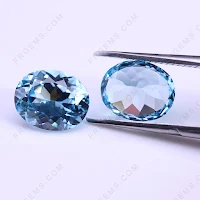What is an Aquamarine?
An aquamarine gemstone reflects the beauty of the sea and sky with stunning hues of blue. It's only fitting that the word aquamarine derives from the Latin word for sky and water. Coveted in ancient and modern cultures, aquamarine gemstones are said to represent protection and purity of heart. An ancient Roman legend suggests that aquamarine gemstones can absorb and prolong the feelings of young love.
 |
| Photo Copyright ©️ B Jefferson Bolender via Flickr |
Aquamarine Belongs to The Beryl Family of Gemstones
Aquamarine is a particular type of gemstone in the beryl family. This family includes other precious gems like emerald, Morganite, golden beryl, colourless Goshenite, rare red Bixbite, and green beryl. While you'll mostly find emeralds and aquamarine in jewellery stores, gem enthusiasts mainly collect the others. Aquamarine used to be less popular because of a cheaper alternative called blue topaz, but it's still affordable and valued for its beauty.
 |
| Photo Copyright ©️ geologyscience.com |
Types of Aquamarine Gemstones
The different types of aquamarine gemstones are based primarily on the different colours and qualities of aquamarine crystals. In fact, in true gemological terms (the science of gemstones) there is only one classification of aquamarine and the various names are simply trade names and informal names.
Blue Aquamarine
Aquamarine is the green-blue variety of the mineral beryl and is usually transparent and pale in colour. Naturally occurring aquamarine tends to be greenish-blue depending on the amount and type of iron which causes the blue and green hues. Traditionally, aquamarine is heated to remove the green tinges to produce a purer blue colour, and this is a widely accepted practice. However, some people nowadays prefer the original slightly green tone.
Maxixe Aquamarine is also a type of beryl with a deep blue colour caused by irradiation while on the earth. However, the colour is unstable and fades over time once exposed to light. The stone can be irradiated manually again to produce a deep blue colour; however, it will simply lose its intensity.
 |
| Photo Copyright ©️ Amila Tennakoon via Flickr |
Brazil Aquamarine
Brazil is the primary source of aquamarine gems, and Brazil or Brazilian Aquamarines are very popular and described as bluish-green. Santa Maria Aquamarine is a mine in Brazil known for its medium-dark tone and highly saturated blue colour. Note that often, gems with a particular colour but from various sources may still be referred to by the country or mine where that colour variant was first discovered.
 |
| Photo Copyright ©️ MAURO CATEB via Flickr |
Moss Aquamarine
Traditional high-quality aquamarine is typically transparent with no inclusions. However, as with all crystals, some deposits will produce rough with internal inclusions due to the processes that occurred while forming. Although these are deemed lower quality, some people prefer more earthy, natural looking crystals and have become quite popular. Moss Aquamarine is more greenish and has specks or threads of inclusions made of other minerals.
 |
| Photo Copyright ©️ ebay.co.uk |
Milky Aquamarine
Milky Aquamarine forms as an opaque or translucent gemstone. Light still goes through the stone, but it is not totally transparent. These crystals tend to be pale blue in colour but are less durable than pure aquamarine. They are usually carved into cabochons and not faceted in traditional cuts.
 |
| Photo Copyright ©️ sharongulezianjewelry.com |
Geology & Occurences of Aquamarine Gem Stones
Aquamarine and most beryls are usually found in special rocks called pegmatites. They often form in holes called vugs, surrounded by quartz and feldspar. Aquamarine is often found near tourmalines. Brazil has been the main place to find aquamarine, but now they're mined in Africa (like Kenya, Mozambique, Nigeria, and Tanzania), Pakistan, Madagascar, Siberia, and the United States. Brazil and Africa are where most come from. One of the most extensive high-quality aquamarine crystals ever found, back in the early 1900s, weighed 200 kilograms and was from Brazil. It was so clear that you could read through it like glass.
 |
| Photo Copyright ©️ pickpik.com |
Are there Lab-Created Aquamarines?
Aquamarines can be synthesized; an examination under a microscope may find some indications of synthetic origin. However, professional gem labs have advanced instruments that can distinguish natural from created aquamarines.
 |
| Photo Copyright ©️ frgems.com |
Are Aquamarine Gemstones Enhanced?
Most aquamarines come out of the ground with a greenish tint, but this will disappear after heating to 375° C, which leaves a pure blue colour. Removing aquamarine's green tinting through heat treatment is very common. In the past, this was done routinely. Nowadays, a more sophisticated public has started appreciating slightly green, untreated aquamarines. However, distinguishing this heating process proves impossible. Therefore, gem graders should describe pure blue aquamarines as "probably heat treated."
 |
| Photo Copyright ©️ researchgate.net |
